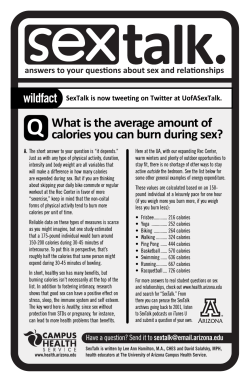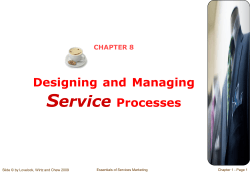
Transition Nutrition: How to transition from pureed diet to regular textures
Transition Nutrition: How to transition from pureed diet to regular textures Transitioning TIPS Introduce only one new food per day; try the same food for 2 days before putting it on your “safe foods” list Avoid cores and skins of fruits and vegetables at first Eat only soft foods that are easy to digest and work up to normal texture Chew, chew, chew, before you try another bite Fluids Still aim for 64 oz of fluid/day (4 oz/hr) Low calorie (<20 cals per serving), no carbonation/bubbles DON’T eat and drink at the same time (wait 30 min after eating to drink) Food/meal/snack planning Goal for first several months 60 grams of protein/day Volume: approximately ½ cup to ¾ cup at a time (depends on texture) Measure/weigh your food to know how much you tolerate Keep a food journal to track intake Move to more SOLID foods – they SIT LONGER in your pouch/sleeve Eat breakfast within 2 hours of waking up Begin to go 3-4 hours between meals NO added sugar or alcohol Continue to focus on protein choices: scrambled eggs, tuna/egg/chicken salad (with low fat mayo/plain greek yogurt), fish/seafood, moist chicken (no skin), ground turkey/chicken breast, ground beef (96%), beans, lowfat cheese, tofu, natural peanut butter, skim milk, no added sugar yogurts, cottage cheese PAIR up your PROTEIN options with your PRODUCE – soft fruits & cooked veggies first, then any fruits/veggies (fresh, raw, frozen, canned) Limit to 2 starch servings/day (after protein/produce), limit ‘sliders’ Vitamins Continue to take multivitamin 2/day (can switch to tablet) and vitamin B12 Time to start your calcium citrate (1500 mg/day in 3 divided doses) Exercise Start exercising! Faster, longer, harder! Aim for >30 minutes/day MUSC Bariatric Surgery Program ~ (843)-876-4307~ www.muschealth.com/weightlosssurgery Rev 7/2014 Helpful hints for transitioning to a solid “regularly” textured diet Eat slowly and be aware of when you feel full. When you feel full, stop eating! If you continue to eat, you may develop intense chest pain and vomit. You may only be able to eat a few bites of food at a time, eating up to 4-6 “meals” a day. Chew, chew, chew! You need to make sure you chew your food very well before you swallow it. This makes it easier to digest and pass from your gastric pouch into your small intestine. Avoid drinking fluids 30 minutes before and with your meals. If you fill up your small gastric pouch with liquid, you won't have room for your food. Furthermore, the liquids may accelerate passage of the solid food out of the stomach and possibly cause some discomfort. If you need to, take only small sips of liquids while eating, but don’t drink large amounts during meals. Drink enough fluid between meals to meet your fluid requirements. You need eight cups (64 oz.) of fluid per day to avoid dehydration. You should carry a water bottle with you and sip on low/no calorie liquids throughout the day to get enough fluids. Avoid sticky gummy foods. These foods can stick together and form a ball in your gastric pouch, causing nausea and sometimes vomiting. Sticky foods include: white bread, rolls, buns, pasta, rice, macaroni and cheese. Avoid tough or rubbery meats. Avoid steak, pork chops, ham, and other tough meats at first. Meat is a great source of protein, but it needs to be soft and tender for you to digest it. Try a slow cooking method to make your meat tender, such as a crock-pot, boiling or cooking at a low temperature over a long period of time. Avoid food/beverages high in sugar. High sugar foods can cause "dumping syndrome." After gastric bypass surgery, some people feel light-heated, sweaty or faint soon after consuming sugar. Sugary foods and drinks are also high in calories and low in nutrition. Avoid added sugars FOREVER! Avoid extremes in the temperature of your foods and beverages. Some patients experience spasms or cramps with very hot or cold food/beverages. Try lukewarm versions. Limit high fat foods. These foods may make you feel nauseated. They are also high in calories and will slow down your weight loss. Try changing to a fat-free or light comparable product. Only try one new food at a time. This way if you cannot tolerate the food you will know exactly what your new pouch does not like. Start taking calcium citrate supplements. Because your surgery is designed for malabsorption, you will need to take calcium forever! You need 1500-2000 mg per day in divided doses of 500-600 mg, 3-4 times per day (typically 2 pills, 3 times each day). Remember that the gastric bypass pouch was designed for you to feel full on SOLID foods. You are SUPPOSED to get full quickly! Liquids and soft slider foods will travel quickly through your pouch and will not produce that “full” feeling that you paid for! If a few bites of solid protein foods like meat feel ‘heavy’ in your pouch, enjoy it! Try not to gravitate to liquid foods that you can consume more of, or that “go down easy”. MUSC Bariatric Surgery Program ~ (843)-876-4307~ www.muschealth.com/weightlosssurgery Rev 7/2014 Meal Plan Meat Milk Veg. Fruit Time Food/Amount Starch Fat Fluid Group Grams Protein MUSC Bariatric Surgery Program ~ (843)-876-4307~ www.muschealth.com/weightlosssurgery Rev 7/2014 Choices for Calcium Supplements Pills Citracal petite 1 pill = 200 mg and 250 IU vitamin D Dosing: 2 pills, 4 times per day (8 pills=1600 mg ca, 2000 IU vit D, 0 calories) Citracal Max 1 pill = 315 mg and 250 IU vitamin D Dosing: 2 pills, 3 times per day (6 pills=1890 mg ca, 1500 IU vit D, 0 calories)) Chewables Calcium citrate chew (aka “Chewy Bites”) by Bariatric Advantage (www.bariatricadvantage.com) 1 chew = 250 mg Ca and 125 IU vitamin D (plus 15 calories) In raspberry, chocolate, caramel or lemon crème Dosing: 2 chews, 3 times per day (6 chews=1500 mg ca, 750 IU vit D, 90 calories) Read the label carefully. You get 630 mg of calcium from this supplement for every TWO tablets you take. To get over 1500 mg of calcium, you would have to take 6 tablets a day. Calcet Creamy Bites (www.bariatriceating.com) 1 chew = 500 mg Calcium and 400 IU vitamin D (plus 40 calories) In Lemon Cream and Chocolate Fudge Dosing: 1 chew, 3 times per day (3 chews=1500 mg ca, 1200 IU vit D, 120 calories) Lozenges by Bariatric Advantage (www.bariatricadvantage.com) 1 lozenge = 500 mg Ca and 300 IU vitamin D In wild cherry, cinnamon, mint or chocolate Dosing: 1 lozenge, 4 times per day (4 lozenges=2000 mg ca, 1200 IU vit D, 0 calories) Calcium Plus 500 Chewable tablet by Celebrate (www.celebratevitamins.com) 1 tablet = 500 mg Calcium and 267 IU vitamin D (plus 7 calories) In berries n’ cream, orange burst and cherry tart Dosing: 1 tablet, 3 times per day (3 tablets=1500 mg ca, 1000 IU vit D, 20 calories) Powder/Crystals - Dissolves in water or most liquids, in tubs or convenient individual serving packets Calcium crystals by Bariatric Advantage (www.bariatricadvantage.com) 1 pkt or 2 level scoops = 600 mg Ca and 500 IU vitamin D (plus 15 calories) Unflavored Dosing: 1 dose, 3 times per day (3 dose=1800 mg ca, 1500 IU vit D, 45 calories) UpCal D (www.amazon.com) 1 dose = 500 mg and 250 IU vitamin D (plus 10 calories) Unflavored Dosing: 1 dose, 3 times per day (3 dose=1800 mg ca, 1500 IU vit D, 30 calories) Liquid Tropical Oasis (www.tropicaloasis.com or www.bariatriceating.com) 1 Tbsp (1/2 fl oz) = 250 mg Ca and 100 IU vitamin D (plus 5 calories) In orange crème Dosing: 2 Tbsp, 3 times per day (6 T=1500 mg ca, 600 IU vit D, 30 calories) 1 dose = 2 Citracal Max = 2 BA Chewy Bites = 1 BA Crystal = 1 Calcet You need 3 doses/day Don’t forget to check out the ART Outpatient Pharmacy located on 1U for your supplement needs MUSC Bariatric Surgery Program ~ (843)-876-4307~ www.muschealth.com/weightlosssurgery Rev 7/2014
© Copyright 2025











